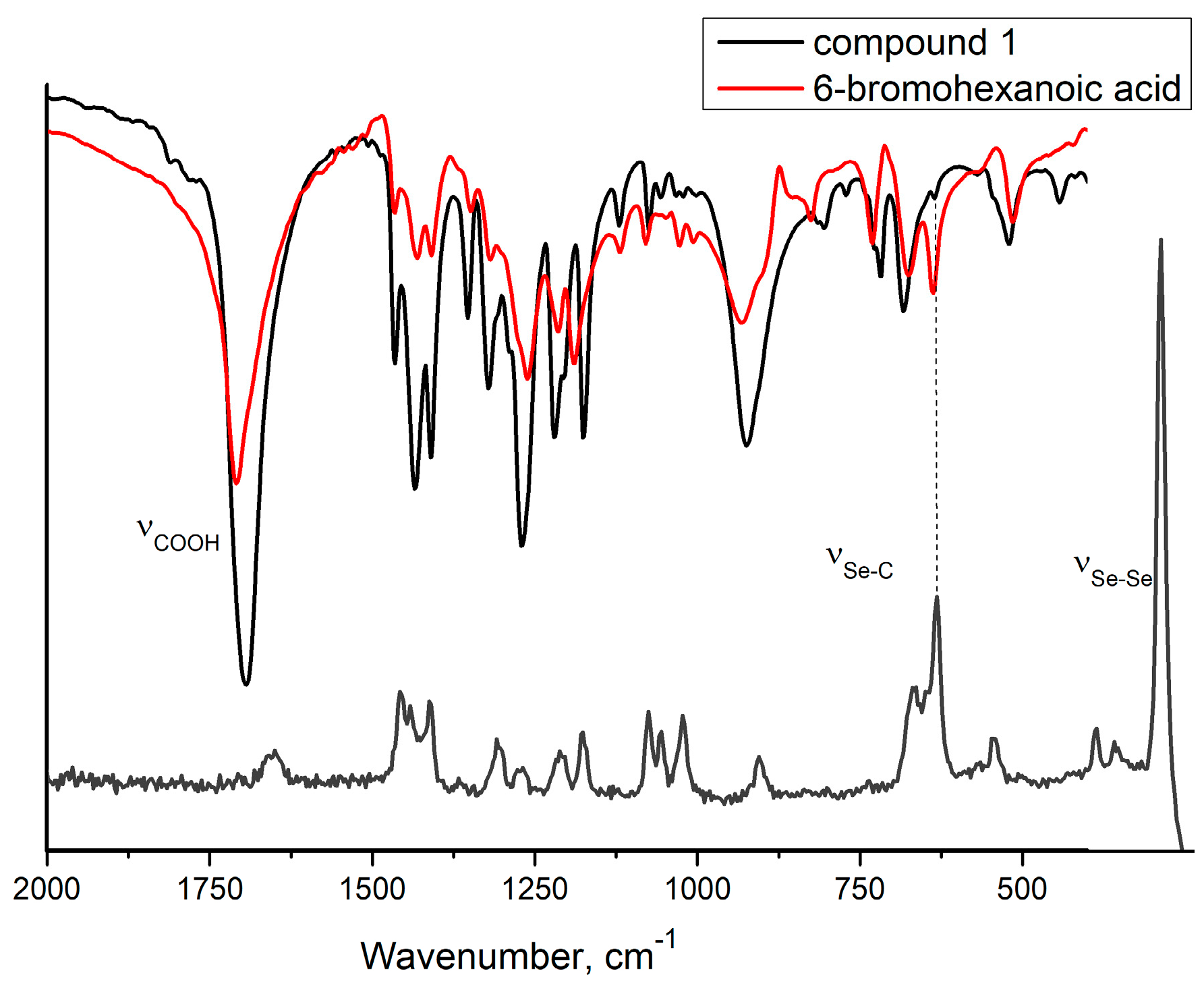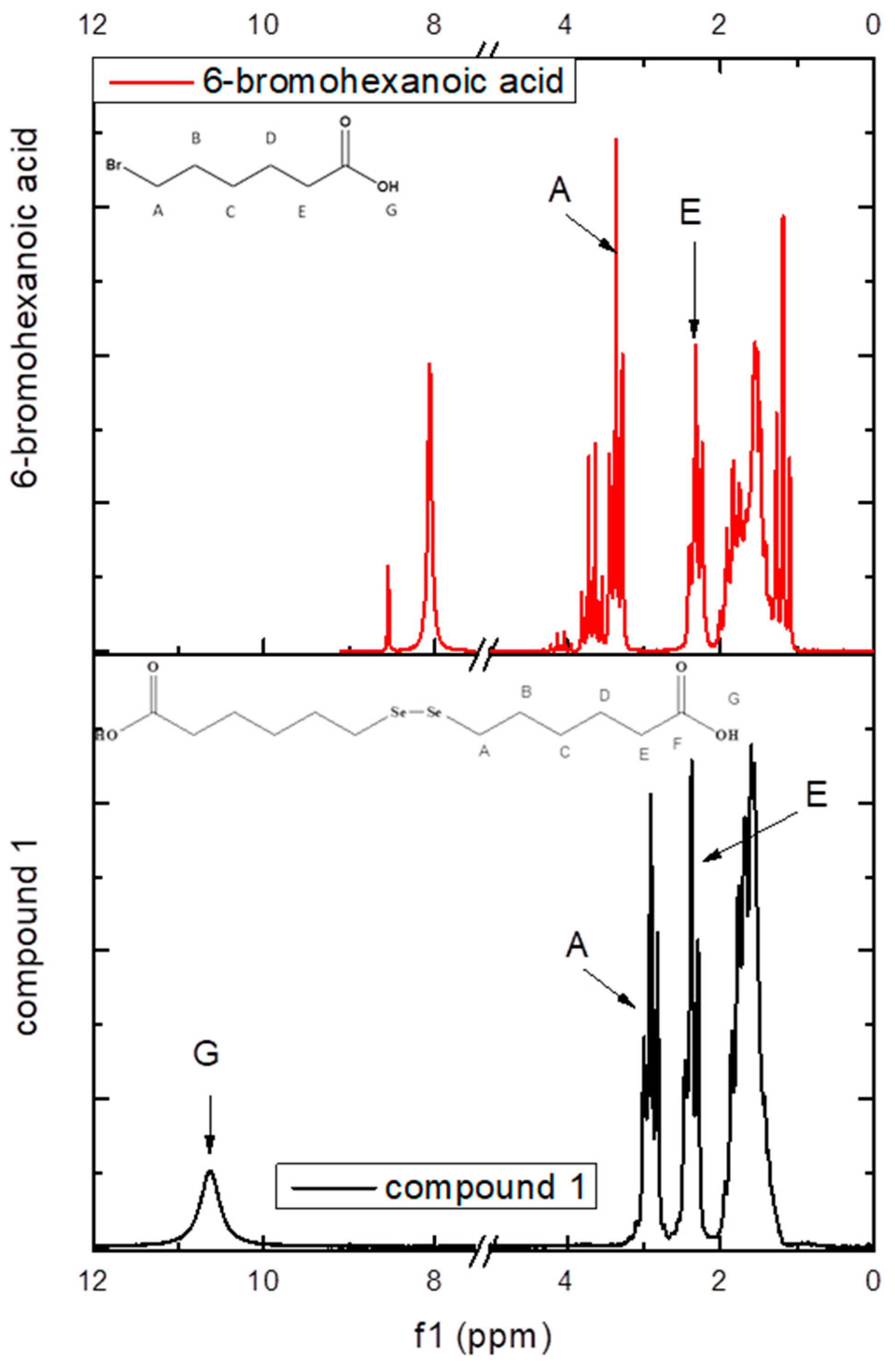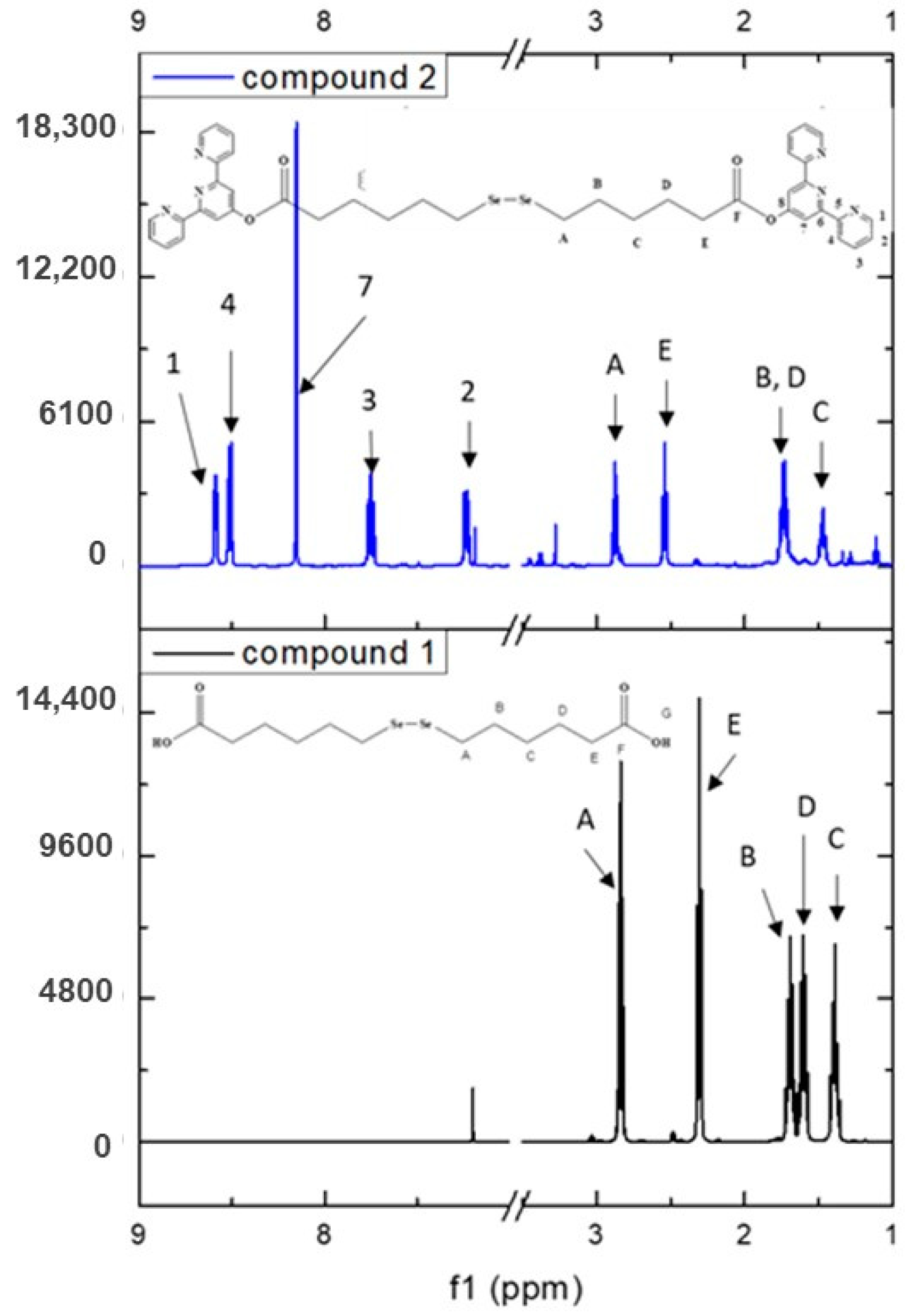Bis(2,6-di(pyridin-2-yl)pyridin-4-yl)-6,6′-(1,2-diselanediyl)dihexanoate
Abstract
:1. Introduction
2. Results
2.1. Synthesis
2.2. Characterization
3. Materials and Methods
3.1. Synthesis of Compound 1
3.2. Synthesis of Compound 2
4. Conclusions
Supplementary Materials
Author Contributions
Funding
Data Availability Statement
Acknowledgments
Conflicts of Interest
References
- Wei, C.; He, Y.; Shi, X.; Song, Z. Terpyridine-metal complexes: Applications in catalysis and supramolecular chemistry. Coord. Chem. Rev. 2019, 35, 1–19. [Google Scholar] [CrossRef]
- Husson, J. 4′-(N-(2-Cyanoethyl)pyrrol-2-yl)-2,2′:6′,2″-terpyridine. Molbank 2023, 2023, M1689. [Google Scholar] [CrossRef]
- Eryazici, I.; Moorefield, C.N.; Newkome, G.R. Square-Planar Pd(II), Pt(II), and Au(III) Terpyridine Complexes: Their Syntheses, Physical Properties, Supramolecular Constructs, and Biomedical Activities. Chem. Rev. 2008, 108, 1834–1895. [Google Scholar] [CrossRef] [PubMed]
- Winter, A.; Gottschaldt, M.; Newkome, G.R.; Schubert, U.S. Terpyridines and their Complexes with First Row Transition Metal Ions: Cytotoxicity, Nuclease Activity and Self-Assembly of Biomacromolecules. Curr. Top. Med. Chem. 2012, 12, 158–175. [Google Scholar] [CrossRef] [PubMed]
- Andelescu, A.A.; Heinrich, B.; Spirache, M.A.; Voirin, E.; La Deda, M.; Di Maio, G.; Szerb, E.I.; Donnio, B.; Costisor, O. Playing with Pt (II) and Zn (II) coordination to obtain luminescent metallomesogens. Chem. Eur. J. 2020, 26, 4850–4860. [Google Scholar] [CrossRef] [PubMed]
- La Deda, M.; Di Maio, G.; Candreva, A.; Heinrich, B.; Andelescu, A.-A.; Popa, E.; Voirin, E.; Badea, V.; Amati, M.; Costişor, O.; et al. Very intense polarized emission in self-assembled room temperature metallomesogens based on Zn(II) coordination complexes: An experimental and computational study. J. Mater. Chem. C 2022, 10, 115–125. [Google Scholar] [CrossRef]
- Andelescu, A.A.; Ilies, S.; Cretu, C.; Popa, E.; Marinescu, S.; Heinrich, B.; Manea, F.; Negrea, S.; Donnio, B.; Szerb, E.I. Pentacoordinated Liquid Crystalline Zn (II) Complex Organized in Smectic Mesophase: Synthesis, Structural and Electrochemical Properties. Appl. Sci. 2022, 12, 8306. [Google Scholar] [CrossRef]
- Popa, E.; Andelescu, A.A.; Ilies, S.; Visan, A.; Cretu, C.; Scarpelli, F.; Crispini, A.; Manea, F.; Szerb, E.I. Hetero-Bimetallic Ferrocene-Containing Zinc(II)-Terpyridyl-Based Metallomesogen: Structural and Electrochemical Characterization. Materials 2023, 16, 1946. [Google Scholar] [CrossRef]
- Malarz, K.; Zych, D.; Gawecki, R.; Kuczak, M.; Musioł, R.; Mrozek-Wilczkiewicz, A. New derivatives of 4’-phenyl-2,2’:6’,2’’-terpyridine as promising anticancer agents. Eur. J. Med. Chem. 2021, 212, 113032. [Google Scholar] [CrossRef]
- Musiol, R.; Malecki, P.; Pacholczyk, M.; Mularski, J. Terpyridines as promising antitumor agents: An overview of their discovery and development. Expert Opin. Drug. Discov. 2022, 17, 259–271. [Google Scholar] [CrossRef]
- Kunwar, A.; Bansal, P.; Jaya Kumar, S.; Bag, P.P.; Paul, P.; Reddy, N.D.; Kumbhare, L.B.; Jain, V.K.; Chaubey, R.C.; Unnikrishnan, M.K.; et al. In vivo radioprotection studies of 3,3′-diselenodipropionic acid, a selenocystine derivative. Free Radic. Biol. Med. 2020, 48, 399–410. [Google Scholar] [CrossRef] [PubMed]
- Nie, Y.; Zhong, M.; Li, S.; Li, X.; Zhang, Y.; Zhang, Y.; He, X. Synthesis and potential anti-cancer activity of some novel 3 selenocyanates and diselenides. Chem. Biodivers. 2020, 17, e1900603. [Google Scholar] [CrossRef] [PubMed]
- Kostić, M.D.; Divac, V.M. Diselenides and Selenocyanates as Versatile Precursors for the Synthesis of Pharmaceutically Relevant Compounds. Curr. Org. Synth. 2022, 19, 317–330. [Google Scholar] [CrossRef] [PubMed]
- Banerjee, B.; Koketsu, M. Recent developments in the synthesis of biologically relevant selenium-containing scaffolds. Coord. Chem. Rev. 2017, 339, 104–127. [Google Scholar] [CrossRef]
- Nogueira, C.W.; Zeni, G.; Rocha, J.B. Organoselenium and organotellurium compounds: Toxicology and pharmacology. Chem. Rev. 2004, 104, 6255–6285. [Google Scholar] [CrossRef] [PubMed]
- Trang, C.D.M.; Saala, T.; Inkpen, M.S. Methyldisulfide groups enable the direct connection of air-stable metal bis(terpyridine) complexes to gold surfaces. Dalton Trans. 2023, 52, 7836–7842. [Google Scholar] [CrossRef]
- Constable, E.C.; Hermann, B.A.; Housecroft, C.E.; Neuburger, M.; Schaffner, S.; Scherer, L.J. 2,2′:6′,2″-Terpyridine-4′(1′H)-thione: A missing link in metallosupramolecular chemistry. N. J. Chem. 2005, 29, 1475–1481. [Google Scholar] [CrossRef]
- Romashkina, R.B.; Majouga, A.G.; Beloglazkina, E.K.; Pichugina, D.A.; Askerka, M.S.; Moiseeva, A.A.; Rakhimov, R.D.; Zyk, N.V. Sulfur-containing terpyridine derivatives: Synthesis, coordination properties, and adsorption on the gold surface. Russ. Chem. Bull. 2012, 61, 2265–2281. [Google Scholar] [CrossRef]
- Zhang, W.; Lin, W.; Pei, Q.; Hu, X.; Xie, Z.; Jing, X. Redox-Hypersensitive Organic Nanoparticles for Selective Treatment of Cancer Cells. Chem. Mater. 2016, 28, 4440–4446. [Google Scholar] [CrossRef]
- Han, W.; Zhang, S.; Qian, J.; Zhang, J.; Wang, X.; Xie, Z.; Xu, B.; Han, Y.; Tian, W. Redox Responsive Fluorescent nanoparticles based on Diselenide-containing AIEgens for Cell imaging and Selective Cancer Therapy. Chem. Asian J. 2019, 14, 1745–1753. [Google Scholar] [CrossRef]
- Frizon, T.E.; Rafique, J.; Saba, S.; Bechtold, I.H.; Gallardo, H.; Braga, A.L. Synthesis of Functionalized Organoselenium Materials: Selenides and Diselenides Containing Cholesterol. EurJOC 2015, 16, 3470–3476. [Google Scholar] [CrossRef]
- Hailemeskel, B.Z.; Addisu, K.D.; Prasannan, A.; Lakew, M.S.; Kao, C.-Y.; Tsai, H.-C. Synthesis and characterization of diselenide linked poly(ethylene glycol) nanogel as multi-responsive drug carrier. Appl. Surf. Sci. 2018, 449, 15–22. [Google Scholar] [CrossRef]
- Helios, K.; Pietraszko, A.; Zierkiewicz, W.; Wójtowicz, H.; Michalska, D. The crystal structure, infrared, Raman and density functional studies of bis(2-aminophenyl) diselenide. Polyhedron 2011, 30, 2466–2472. [Google Scholar] [CrossRef]
- Back, T.G.; Codding, P.W. Studies of the dihedral angle of a crowded diselenide by X-ray crystallography and ultraviolet spectroscopy. Can. J. Chem. 1983, 61, 2749–2752. [Google Scholar] [CrossRef]





| Sample | Abs, λmax/nm (ε/M−1 cm−1) | Em, λmax/nm | ϕ/% | τ/ns |
|---|---|---|---|---|
| tpyOH | 250 (8400) | |||
| 290 (8700) | 410, 435 | 12.95 | 0.43 | |
| 313 (5400) | ||||
| Compound 1 | 308 (640) | - | - | - |
| Compound 2 | 278 (39,000) | |||
| 312 (23,200) | 349 | 0.78 | 1.07 | |
| 322 (17,300) |
Disclaimer/Publisher’s Note: The statements, opinions and data contained in all publications are solely those of the individual author(s) and contributor(s) and not of MDPI and/or the editor(s). MDPI and/or the editor(s) disclaim responsibility for any injury to people or property resulting from any ideas, methods, instructions or products referred to in the content. |
© 2023 by the authors. Licensee MDPI, Basel, Switzerland. This article is an open access article distributed under the terms and conditions of the Creative Commons Attribution (CC BY) license (https://creativecommons.org/licenses/by/4.0/).
Share and Cite
Popa, E.; Andelescu, A.A.; Badea, V.; Svera, P.; Szerb, E.I. Bis(2,6-di(pyridin-2-yl)pyridin-4-yl)-6,6′-(1,2-diselanediyl)dihexanoate. Molbank 2024, 2024, M1752. https://doi.org/10.3390/M1752
Popa E, Andelescu AA, Badea V, Svera P, Szerb EI. Bis(2,6-di(pyridin-2-yl)pyridin-4-yl)-6,6′-(1,2-diselanediyl)dihexanoate. Molbank. 2024; 2024(1):M1752. https://doi.org/10.3390/M1752
Chicago/Turabian StylePopa, Evelyn, Adelina A. Andelescu, Valentin Badea, Paula Svera (m. Ianăşi), and Elisabeta I. Szerb. 2024. "Bis(2,6-di(pyridin-2-yl)pyridin-4-yl)-6,6′-(1,2-diselanediyl)dihexanoate" Molbank 2024, no. 1: M1752. https://doi.org/10.3390/M1752
APA StylePopa, E., Andelescu, A. A., Badea, V., Svera, P., & Szerb, E. I. (2024). Bis(2,6-di(pyridin-2-yl)pyridin-4-yl)-6,6′-(1,2-diselanediyl)dihexanoate. Molbank, 2024(1), M1752. https://doi.org/10.3390/M1752







